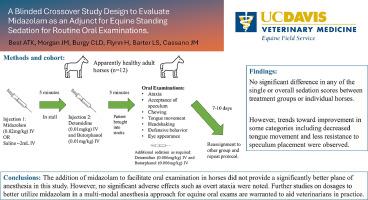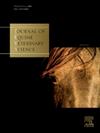A blinded crossover study design to evaluate midazolam as an adjunct for equine standing sedation for routine oral examinations
IF 1.3
3区 农林科学
Q2 VETERINARY SCIENCES
引用次数: 0
Abstract
This study aimed to evaluate the effects of including midazolam to a common equine standing sedation protocol for routine oral examination. Twelve horses underwent two examinations at least seven days apart. Horses were randomly assigned to receive midazolam intravenously (IV) (0.02mg/kg) or a placebo injection of saline (2-2.5mL IV). Five minutes later, detomidine (0.01mg/kg) and butorphanol (0.01mg/kg) were administered IV and horses were placed in standing stocks. A veterinarian blinded to the treatment protocol used a descriptive scoring system to assess degree of ataxia, acceptance of speculum, chewing on the speculum, headshaking, tongue movement, resistance to palpation, and eye appearance as related to the grimace score. During each examination, additional sedation of IV detomidine (0.006mg/kg) and butorphanol (0.006mg/kg) was administered at the discretion of the blinded practitioner to facilitate safe examination. At the second examination horses received the opposite treatment protocol and, following examination, a routine occlusal adjustment. Scores were compared using JMP software with a repeated measures mixed effects model, treatment as a fixed effect and horse and horse/treatment interaction as random effects. Significance was set at P<0.05. There were no significant differences in any of the single or overall sedation scores between treatment groups or within individual horses (P=0.3). Trends towards improvement of some assessed characteristics of sedation, including decreased tongue movement and less resistance to acceptance of speculum were observed. The use of midazolam may prove beneficial for routine oral examination, as well as other standing procedures, with no obvious undesired side effects.

采用盲法交叉研究设计,评估咪达唑仑作为常规口腔检查马匹站立镇静的辅助手段。
本研究旨在评估在常规口腔检查的常用马匹站立镇静方案中加入咪达唑仑的效果。12 匹马接受了两次检查,每次检查至少间隔 7 天。马匹被随机分配接受咪达唑仑静脉注射(0.02 毫克/千克)或生理盐水安慰剂注射(2-2.5 毫升静脉注射)。五分钟后,静脉注射地托咪定(0.01 毫克/千克)和丁吗啡酚(0.01 毫克/千克),并将马匹置于站立架上。一名对治疗方案保密的兽医使用描述性评分系统来评估共济失调程度、接受窥器的程度、咀嚼窥器的程度、摇头程度、舌头运动程度、对触诊的抵抗力以及与龇牙评分相关的眼睛外观。在每次检查过程中,盲人医生都会酌情使用地托咪定(0.006 毫克/千克)和丁吗啡诺(0.006 毫克/千克)静脉注射镇静剂,以确保检查安全。在第二次检查中,马匹接受了相反的治疗方案,并在检查后接受了常规的咬合调整。采用重复测量混合效应模型,以治疗为固定效应,马匹和马匹/治疗交互作用为随机效应,使用 JMP 软件对得分进行比较。显著性设定为 P
本文章由计算机程序翻译,如有差异,请以英文原文为准。
求助全文
约1分钟内获得全文
求助全文
来源期刊

Journal of Equine Veterinary Science
农林科学-兽医学
CiteScore
2.70
自引率
7.70%
发文量
249
审稿时长
77 days
期刊介绍:
Journal of Equine Veterinary Science (JEVS) is an international publication designed for the practicing equine veterinarian, equine researcher, and other equine health care specialist. Published monthly, each issue of JEVS includes original research, reviews, case reports, short communications, and clinical techniques from leaders in the equine veterinary field, covering such topics as laminitis, reproduction, infectious disease, parasitology, behavior, podology, internal medicine, surgery and nutrition.
 求助内容:
求助内容: 应助结果提醒方式:
应助结果提醒方式:


